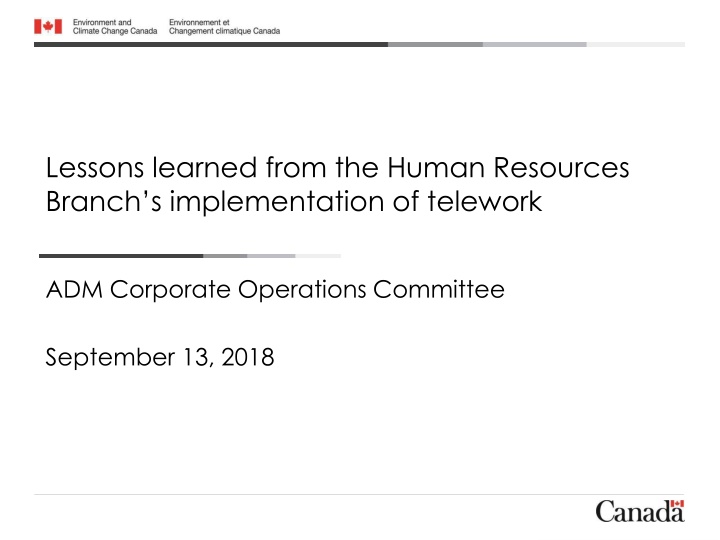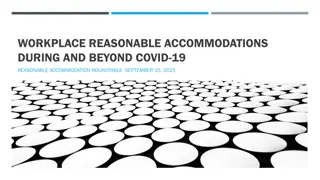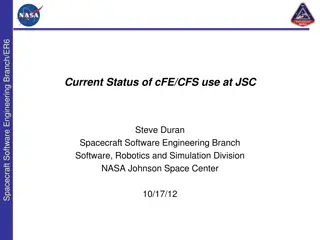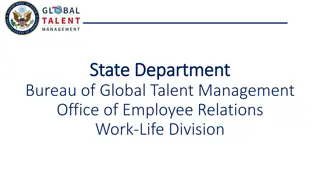Lessons Learned from Human Resources Branch’s Telework Implementation
This presentation highlights the lessons learned from the Human Resources Branch’s implementation of telework, discussing the Treasury Board's policy, Environment and Climate Change Canada's telework guidelines, roles and responsibilities, potential benefits and disadvantages of telework, HRB's experience, and key definitions related to telework. It aims to provide valuable insights for organizations considering or already implementing telework arrangements.
Download Presentation

Please find below an Image/Link to download the presentation.
The content on the website is provided AS IS for your information and personal use only. It may not be sold, licensed, or shared on other websites without obtaining consent from the author.If you encounter any issues during the download, it is possible that the publisher has removed the file from their server.
You are allowed to download the files provided on this website for personal or commercial use, subject to the condition that they are used lawfully. All files are the property of their respective owners.
The content on the website is provided AS IS for your information and personal use only. It may not be sold, licensed, or shared on other websites without obtaining consent from the author.
E N D
Presentation Transcript
Lessons learned from the Human Resources Branch s implementation of telework ADM Corporate Operations Committee September 13, 2018
Agenda Objective Treasury Board s Policy on Telework Environment and Climate Change Canada s Telework Guidelines Roles and Responsibilities Potential Benefits of Telework Potential Disadvantages of Telework HRB s Experience HRB s Lessons Learned Questions
Objective The objective of this presentation is to provide information on the policy and guidelines on telework, and to share lessons learned from Human Resources Branch s (HRB) implementation of telework.
Treasury Boards Policy on Telework Treasury Board s policy on telework outlines the options to work in a telework placeoutside of the designated workplace, such as home, for positions in the federal public service. Participation in telework is voluntary, that is no employee shall be required to telework. Key Definitions: Telework: a flexible work arrangement whereby employees have approval to carry out some or all of their work duties from a telework place Telework place: the alternative location where the employee is permitted to carry out the work otherwise performed at or from their designated workplace Designated workplace: the employee's designated workplace or business address where the employee would work if there were no telework situation
Environment and Climate Change Canada Telework Guidelines These guidelines have been developed in accordance with Treasury Board's Telework Policy. Provides specific guidance and support to ECCC supervisors/managers and employees in the assessment, planning, designing and implementation stages when considering a telework agreement. Telework requests are approved at the discretion of management on a case-by-case basis. Participation of both the employee and the employer in a telework arrangement is voluntary and may be cancelled or temporarily suspended at any time by either party with reasonable notice.
Roles and Responsibilities The manager and the employee are responsible for fulfilling their respective obligations arising from this directive and the telework agreement. Employee/Manager Both managers and employees are responsible to ensure that operational needs of the organization are met and that neither productivity nor costs are negatively impacted by the application of this policy. The supervisor/manager and employee shall review the telework arrangement every six (6) months to ensure that it still complies with the signed telework agreement (which should be renewed annually) and that performance objectives are met and issues are addressed accordingly. Manager Employee Before approving a telework agreement, the supervisor/manager shall consult the Checklist for supervisors/managers . Supervisors/managers may also wish to refer to the Telework: Questions and Answers to ensure conditions of success are met. Prior to proceeding with a telework agreement, the employee shall consult the Checklist for employees and ensure all requirements and/or processes have been addressed. The employee may also wish to refer to Weighing the Advantages and Disadvantages and the Telework: Questions and Answers reference documents.
Employee and Employer Costs Costs related to telework agreement are distributed between the organization and the employee according to the guidelines below: Organization Employee Responsible for the provision of computers and printers as the use of a personal computer is not allowed for telework purposes. Responsible for providing supplies, such as pens and paper, toner and ink cartridges required by the employee to perform their duties. Arrangements to obtain office supplies should be discussed in advance with the employee and subject to normal approval procedures. May be subject to cost recovery for maintenance and support of off-site computer equipment. All general expenses, maintenance costs and all unforeseen costs associated with the use of the telework location (e.g., insurance, heating, electricity, internet and telephone access). Responsible for providing and paying for a connection to high speed internet. Associated costs to correct or eliminate the unsafe working condition. Unless otherwise outlined in the telework agreement, the employee shall supply all office furniture (desk, chair, bookcase, wastebasket, etc.). Telephone needs (cell phone, Blackberry, etc.) and appropriate usage should be discussed with the supervisor/manager. Responsible for bringing the computer equipment to the office for any required maintenance and upgrades that cannot be done remotely. The supplies are furnished by the employer subject to normal approval procedures. If telework arrangement requested by manager, the Department must provide all necessary equipment. If telework arrangement requested by employee, the Department provides at its convenience.
Potential Benefits of Telework Flexibility in the workplace to accommodate work, personal and family needs can result in benefits to organizations and employees such as: Organization Employee a competitive edge for attracting and retaining highly skilled individuals; reduced levels of employee stress and conflict; higher levels of productivity and reduced absenteeism; higher levels of employee satisfaction and motivation; a more satisfying work environment; ability to accommodate employment related needs for employee with disabilities. greater flexibility and improved quality of life (more relaxed and quieter environment, and less interruptions); decreased work-related expenses; less commuting time; less stress; higher morale; ability to capitalize on personal peak productivity periods; increased physical comfort.
Potential Challenges of Telework While the advantages outweigh the disadvantages, there is however some potential challenges for the organization and the employee that needs to be considered: Organization Employee possible loss of direct management of employees; possible concerns about public perception; potential for distraction leading to decline in work output. isolation and reduced social interaction; potential increase to home costs; not all jobs are suitable for teleworking.
HRBs Experience In the past two years, HRB has successfully established a culture that fosters telework. More than 70% of HRB s staff have a special work arrangement (e.g., telework). These flexibilities have made HRB an employer of choice in HR across the government and given us a competitive edge for attracting and retaining highly skilled individuals. Moreover, this experience created a more satisfying work environment resulting in: Productivity Employee satisfaction Absenteeism Motivation
Lessons Learned Ensure proper monitoring and review of telework in order to have an updated inventory of arrangements. It is understood that telework is not meant for everybody. Low performers are not permitted to telework until their performance demonstrates improvements. Full time telework arrangements should only be offered on an exceptional basis. Do not want to negatively impact employee s sense of belonging with the organization. All telework decisions should be made in a fair, equitable and transparent manner, thus reinforcing trust between the employee and the organization.
Annex A - Relevant Documents Documents available on the intranet: Checklist for supervisors/managers Checklist for employees Telework Location Inspection Checklist (OHS) Employees CLC part II Obligation Form Weighing the Advantages and Disadvantages Telework Agreement Form























